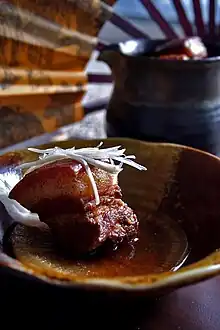| Dongpo pork | |||||||||||
|---|---|---|---|---|---|---|---|---|---|---|---|
 | |||||||||||
| Chinese name | |||||||||||
| Simplified Chinese | 东坡肉 | ||||||||||
| Traditional Chinese | 東坡肉 | ||||||||||
| |||||||||||
| Japanese name | |||||||||||
| Kana | ドンポーロウ | ||||||||||
| Katakana | トンポーロウ | ||||||||||
| |||||||||||
Dongpo pork (simplified Chinese: 东坡肉; traditional Chinese: 東坡肉; pinyin: dōngpōròu), also known as Dongpo meat,[1] is a Hangzhou dish[2] made by pan-frying and then red-cooking pork belly.[3] The pork is typically cut into thick, approximately 5 centimeter (2.0 inch) squares, with an even distribution of fat and lean meat, while retaining the skin. The texture is tender and juicy without being excessively greasy, accompanied by a fragrant aroma of wine. The dish is named in honor of Su Dongpo (Su Shi), a distinguished Song Dynasty poet and gastronome.[4]
Origins
While facing financial hardship during his exile in Huangzhou following the Crow Terrace Poetry Trial, Su Dongpo innovated upon the conventional method of preparing pork. He marinated the pork in a mixture of huangjiu (yellow wine), rock sugar, and soy sauce, and simmered it on low heat for long hours. He composed a poet titled "An Ode to Pork", where he described that pork was a most affordable meat source locally, and by a slowing cooking method, he obtained both a delicacy and a survival food for the families.[5] The recipe was subsequently adopted and developed by people in the Hangzhou area, the capital city of South Song Dynasty.
In Chinese Gastronomy, Lin Hsiang Ju and Lin Tsuifeng included the recipe "The Fragrance of Pork: Tungpo Pork", and remarked that the "square of fat is named after Su Tungpo, the poet, for unknown reasons. Perhaps it is just because he would have liked it."[6]
See also
- Kakuni – Japanese braised pork dish
- Humba – Filipino braised pork dish
- Red braised pork belly – Chinese braised pork dish
- List of pork dishes
- Su Shi (Su Dongpo)
References
- ↑ Sakaki, Atsuko (2005). Obsessions with the Sino-Japanese Polarity in Japanese Literature. University of Hawaii Press. p. 87. ISBN 978-0-8248-2918-6.
- ↑ Cannon, Gwen, ed. (2010). Michelin Must Sees Shanghai. London: Michelin Apa Publications. p. 133. ISBN 978-1-906261-99-3.
- ↑ Yoke, Wong Ah (May 8, 2016). "Video: How to make braised Dongpo pork". The Straits Times. Retrieved June 24, 2019.
- ↑ Law, Eugene (2004). Intercontinental's best of China. Beijing: China Intercontinental Press. p. 336. ISBN 978-7-5085-0429-2.
- ↑ 据《清稗类钞》 饮食类三 《东坡肉》条:“《东坡集》有食猪肉诗云:“黄州好猪肉,价钱等粪土,富者不肯吃,贫者不解煮;慢着火、少著水,柴头罨烟焰不起,待他自熟莫催它,火候足时它自美;早晨起来打两碗,饱得自家君莫管。”
- ↑ Hsiang-Ju Lin and Tsuifeng Lin, with a Foreword and Introduction by Lin Yutang, Chinese Gastronomy. New York,: Hastings House, 1969. ISBN 0-8038-1131-4; various reprints), p 55.